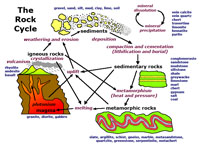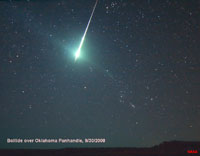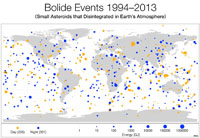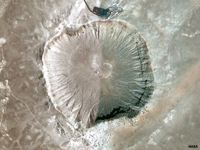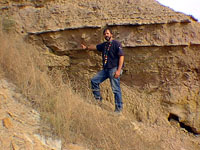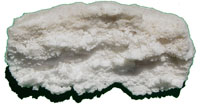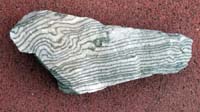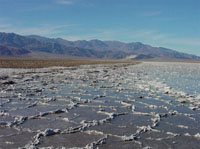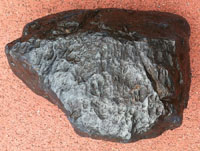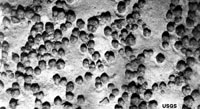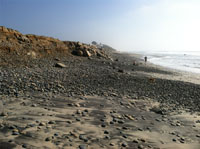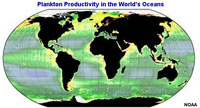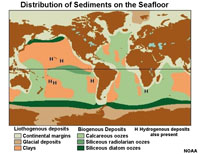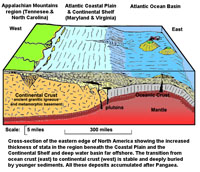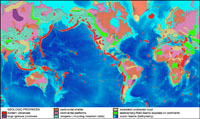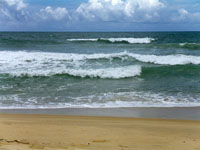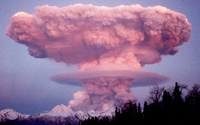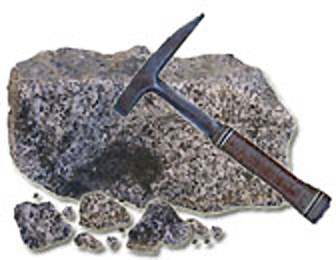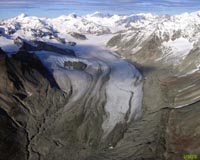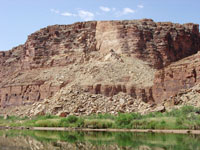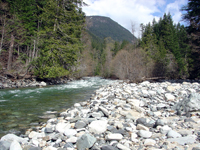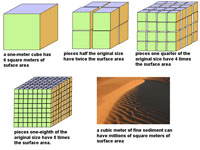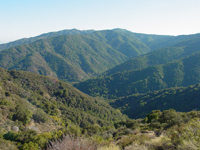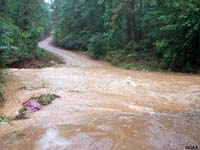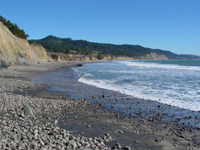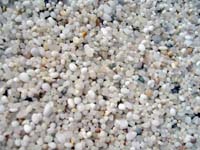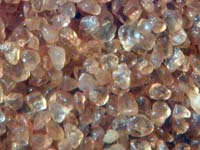
Oceanography 101 |
Return to class home page |
Chapter 6 - Marine Sediments |
Classification of Sediments and Sedimentary RocksSediments (and sedimentary rocks) are classified in by origin of source material and by grain size.There are 4 sources of sediments (and sedimentary rocks): a) Cosmogenous: material that falls to the Earth surface from outer space. b) Hydrogenous: material precipitated directly seawater. c) Lithogenous: material derived from erosion of other rocks, typically from continental sources. d) Biogenous: material formed from the accumulation of remains of living organism. |
Neritic and Pelagic SedimentsThe term neritic is used to described the shallow part of the ocean near a coast and overlying the continental shelf.Neritic sediments are generally shallow water deposits formed close to land. They are dominated by lithogenous sources and are typically deposited quickly. Neritic sediments cover about ¼ of sea floor and are near landmasses. The term pelagic means "of or relating to the open sea" particularly the upper layers of the ocean away from shore. Pelagic sediments are generally deep-water deposits mostly oozes (see below) and windblown clays. They are typically finer-grained sediments that are deposited slowly. Because they are deposited far beyond the continental margins they are typically less lithogenous and more biogenous depending on biologic productivity. Pelagic sediments cover about ¾ of seafloor and are mostly in deep water. The distribution of neritic or pelagic sediments is controlled by proximity to sources of lithogenous sediments (i.e.: landmasses) and the productivity of microscopic marine organisms. |
Fate of soluble components of rocks: formation of seawaterAs rocks weather and erode, they loose their soluble elemental components, they dissolve in groundwater and surface runoff and are carried away, eventually reaching the ocean. The high level of salt in seawater comes from\ the weathering and erosion of rocks on the surface or the seafloor. Salts dissolved in water flowing off of the continents or water flowing through sediments or rocks underground. Evaporation concentrates salt in seawater. Salt concentrations higher than seawater occur isolated lake basins in arid regions, such as in North America's Great Basin region. Salts end up being concentrated as salts on dry lake beds—or brine in basins such as Mono Lake (CA) or the Great Salt Lake (Utah). Over billions of years, rivers and streams, and groundwater flowing into the oceans have contributed to the saltiness of seawater. Salt in seawater is concentrated by the evaporation of water back into the atmosphere. (See Why is the ocean salty?) |
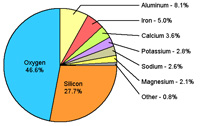 |
 |
| Fig. 6-37. Composition of crustal rocks, some elements are more soluble and others. | Fig. 6-38. Elemental components of salts dissolved in seawater. |
Sediments Classification Based On Grain Size |
|
| Sediments are solid fragments of inorganic or organic material that come from the weathering of rock and soil erosion, and are carried and deposited by wind, water, or ice. They range in size from large blocks to microscopic particles. Figure 6-39 shows the technical definition of sediment particles. However, general usage is as follows ranging from largest to smallest: boulders, cobbles, gravel, sand, silt, and clays. Sediments form from the disintegration of rocks. They are transported, mostly by water, and in the process the fragments are abraded, with sharp edges worn down and the overall shape of particles increasing in roundness. Sediments derived from erosion on land are mostly lithogenous sediments. Clastic sediments and sedimentary rocksThe word clastic is also commonly used to describe sediments or sedimentary rocks composed of fragments (or detritus) derived from older rocks. The word clast means rock fragment; the word is derived from the Greek word klastos which means broken. Gravel, sand, and silt are examples of clastic sediments. Lithogenous sediments (described above) are mostly clastic sediments. A classification of clastic sediments and sedimentary rocks is illustrated in Figure 6-39 and with details discussed below. |
 Fig. 6-39. Classification of sediments by size of clasts (rock fragments) |
How do sediments become sedimentary rocks?Sediments can become lithified into sedimentary rocks once they've been deposited in a stable setting where burial, compaction, and cementation can take place. The processes, collectively called lithification (or diagenesis) typically takes place slowly over time but rates depend on many factors including the chemistry of the sediments and groundwater passing through the sediment, and how quickly or deeply burial takes place. Deposits of unconsolidated sediments typically have high porosity—pores are open spaces between grains filled with gas or fluids (water or in some cases, petroleum). Compaction is the process of gravitation consolidation of sediments, decreasing the volume of pore space between particles of sediment and increasing hardness. Cementation involves processes that harden sediments through the precipitation of minerals in pore spaces between grains of rock and mineral fragments, binding them together (Figure 6-40). Common minerals that form cement include quartz, calcite, limonite, hematite, and clays. The cementing minerals are slowly deposited between grains by groundwater. |
 |
| Fig. 6-40. Cementing minerals fill in spaces between sediment grains as they turn to stone. |
Clastic Sedimentary RocksRocks composed of grains of mineral and rock fragments derived from erosion of other rocks. Three general groups are coarse-grained, sand-size grained, and fine-grained ("mudrocks").Coarse-grained sediments and sedimentary rocks Gravel is rock particles that have been moved by moving water. Gravel usually consists of a mix of the more durable and most abundant rock types in the sediment source areas (Figure 6-41). Gravel deposits typically occur along stream valleys close to mountainous source areas and along rocky coastlines with high wave action. Conglomerate is a sedimentary rock composed of cemented gravel. It consists of rounded to sub-angular fragments (larger than 2 mm in diameter) set in a fine-grained matrix of sand or silt, and commonly cemented by calcium carbonate, iron oxide, silica, or hardened clay; the consolidated equivalent to gravel (Figures 6-42). The composition of grave reflects the rocks the general composition in the area where it comes from. Sand-size-grained sediments and sedimentary rocks Sand goes through degrees of refinement at it moves away from source areas. Sand deposits near mountain ranges may be enriched in feldspars. Volcanic regions may produce sand enriched in dark minerals. "Mature" sand that has traveled long distances in streams, blown by wind, or worked and reworked by waves will be enriched in quartz and individual grains will be very well rounded and well sorted (see below). Large sand deposit accumulate along stream valleys, on beaches, barrier islands, and offshore bars, and in dune fields in coastal areas and in desert environments. Sandstone is a sedimentary rock formed by the consolidation and compaction of sand and held together by a natural cement, such as silica, calcite, and iron-oxide minerals (Figure 6-44). Most sandstone is dominated by the minerals quartz. Fine-grained sediments and sedimentary rocks ("Mudrocks")Mud is a general term lumping together sediments consisting of a mix of clay, silt, and may contain sand. Mud is usually an unsorted mix of fine grain materials. Mud accumulates in quiet water settings separated from where coarser materials have settled out elsewhere (Figure 6-46). Most soil is mud. Mud-rich accumulations are common in river delta regions, swampy coastal regions, tidal flats, and in lake and deep water settings.Mudstone is a fine-grained sedimentary rock formed from the compaction and cementation (lithification) of muddy sediments rich in silt (but may include percentages of fine sand and clay). Shale is a soft, finely stratified sedimentary rock that formed from consolidated mud rich in clay minerals and can be split easily into fragile plates, such as along bedding plains. Shale forms from the compaction of sediment dominated by clays. Clays are composed of any microscopic mineral particles. Most dust is clay sized particles. However, there are several types of clay minerals. Clay minerals are any of various hydrated aluminum silicates that have a fine crystalline structure and are components of clay (sediment). Clay minerals form from the weathering of feldspars and other silicate minerals and are the dominant sediment found on earth. Graywacke (or graywacke or grauwacke, a German word signifying a gray, earthy rock) is a variety of sandstone or mudrock generally characterized by its dark color and poorly sorted angular grains including a mix of quartz, feldspar, dark mafic minerals, and tiny rock fragments cemented in a compact, clay-fine matrix. Generally, graywacke is a featureless dirty-looking, dark brown or gray sandstone or silty mudstone. Graywacke is common in active continental margin regions such as along coastal California (Figures 6-49 and 6-50). |
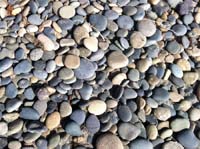 |
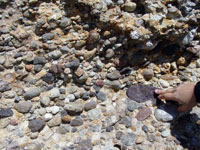 |
| Fig. 6-41. Wave action creates well rounded and sorted gravel. | Fig. 6-42. Conglomerate formed from an ancient gravel deposit. | |
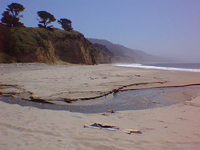 |
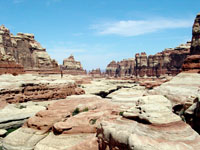 |
|
| Fig. 6-43. Sand is winnowed (sorted) and accumulates on a beach by wave action. | Fig. 6-44. Sandstone outcrops exposed in Utah's Canyonlands National Park | |
 |
 |
|
| Fig. 6-45. Certain kinds of Clays are used to make ceramic pottery. Clay is made up of clay minerals. | Fig. 6-46. Mud accumulates in quiet-water environments as illustrated with these tidal flats. |
|
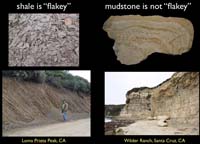 |
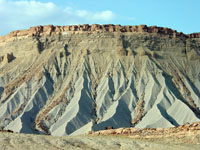 |
|
| Fig. 6-47. Comparison of shale and mudstone. Shale tends to be flaky and splits into thin layers. Mudstone tends to form more massive layers. | Fig. 6-48. Shale (blue gray) and mudstone (brown) outcrops in Utah's Capitol Reef National Park. Marine shales tend to be shades of blue, green, and gray. |
|
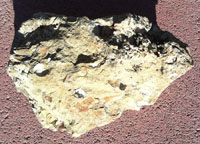 |
 |
|
| Fig. 6-49. Graywacke is a poorly sorted mix of sediments common in marine deposits along active continental margins. | Fig. 6-50. Graywacke is perhaps the most abundant sedimentary rock exposed mountainsides throughout coastal California. |
Unique characteristics of lithogenous depositsSediments preserve other characteristics that may tell information about the environment where they occur. Sediment particle shapes (rounding), degree of sorting, and bedding characteristics are typically unique to different geologic settings.Rounding of sediment grainsWhen particles are moved by running water they become rounded ("roundness" is illustrated in Figure 6-51). The corners hit first and are worn down. The sharp edges are also pounded. The particles may become round boulders or pebbles. Bits of sand move with them. As the water slows the largest particles drop out first, making deposits of round boulders and pebbles called conglomerate. The smaller particles are swept away downstream (unless they are trapped between or beneath the large particles). |
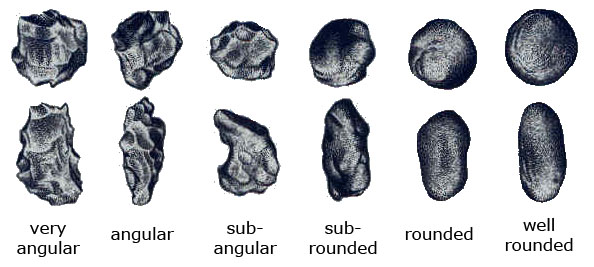 |
| Fig. 6-51. "Roundness" of sediment grains: The farther a particle is moved, the more rounded and spherical it should become. Angular particles tend to be deposited close to their source, they become more rounded the farther they travel downstream. Grains of beach sand are typically well rounded. Dune sand is typically even more rounded and better sorted (Image from Powers, 1959). |
SortingThe ability of running water to move sediments also sorts particles by size and to a lesser degree by shape. This is called sorting (illustrated in Figure 6-52). Sediments exposed to longer transport or exposure to currents and waves tend to be more sorted by shape and size.The amount of sorting depending on the energy conditions and amount of time at which the stream currents or ocean waves works on the particles. For instance, particles of the same mineral that are more rounded and more sorted have traveled farther. |
 |
| Fig. 6-52. Sorting of sedimentary particles. Beach sands the to be very well sorted. River sands tend to be moderately sorted. Deep ocean turbidity current sediments tend to be very poorly sorted.
|
|
| As transportation distance increases, sediment becomes more "mature" and: • Clay content decreases (clays are carried away and deposited in other quiet water settings) • Sorting increases (gravel and sand gets concentrated) • Non-quartz minerals decrease (quartz is both an abundant and is harder than other common minerals) • Grains become more rounded (sharp edge break off easier) |
|
| The sediments sorting, roundness, and sphericity could act as a clue to following either modern or ancient alluvial rocks to their ultimate source (such as for finding gold and diamonds). For example, very well sorted and rounded materials may suggest a source from an older sedimentary rock rather than from freshly exposed igneous rocks. Sand from rivers and stream are very different from sands associated with beach and sand-dune deposits (see Figures 6-53 to 6-56). | |
|
Sedimentary Processes and Sedimentary StructuresLamination and beddingSediments are deposited in layers ranging from paper-thin sheets to massive beds tens to hundreds of feet thick! A laminae (or lamination) is a layer of sediment or sedimentary rock layer only a small fraction of an inch (less than a centimeter) in thickness (see Figure 6-57). Thin lamination is typically associated with fine-grained sediments deposited in quiet or slack-water environments, such as in a lake basin or offshore below the influence of waves and strong currents. Bedding is the smallest division of a sedimentary rock formation or stratigraphic rock series marked by well-defined divisional planes (bedding planes) separating it from layers above and below (see Figure 6-58). |
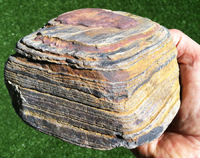 |
 |
| Fig. 6-57. Lamination in shale. Each laminae may be an annual cycle of deposition or a seasonal storm flood event (scale is in mm to cm). | Fig. 6-58. Bedding is layers of sediment deposited in an environmental setting on a scale of hundreds to many thousands of years. |
Sedimentary structures preserved in beddingSedimentary deposits (including sediments and sedimentary rocks) commonly preserve evidence of how they were deposited. Anyone who has been to the beach or a sand dune area have seen ripple marks created by the movement of sand under the influence of wind or water. Listed below are examples of sedimentary structures preserved in bedding of ancient sedimentary rocks. The processes that created them are the same that can be observed occurring today.ripple marks—a series of small ridges produced in sand by water currents or by wind (Figure 6-59). cross bedding—inclined sedimentary structures in a horizontal unit of rock. These tilted structures are deposits from bedforms such as ripples and dunes, and they indicate that the depositional environment contained a flowing fluid (typically, water or wind) (Figure 6-60 and 6-61). desiccation cracks—mudcracks; irregular fracture formed by shrinkage of clay, silt, or mud under the drying effects of atmospheric conditions at the surface (Figure 6-58). graded bedding—bed is one characterized by a systematic change in grain or clast size from the base of the bed to the top. Large fragments tend to settle out fastest from a slowing turbulent flow. biological structures—many kinds of organisms burrow or bore into sediments creating holes for feeding or for shelter (or both). Most marine sedimentary beds preserve bioturbation features - bioturbation means "churning of the sediments" as organisms, typically worms, shrimp, and other invertebrates work through the sediments to eat decaying organic mater (or other organisms feeding there). They also use the burrows as shelter or nesting site. Very often the traces are preserved as structures in the sediment. Trackways, burrows, or resting sites are also common structures preserved in marine sediments. Turbidity Currents and Development of Submarine Canyons and Fans A turbidity flows is a turbid, dense current of sediments in suspension moving along downslope and along the bottom of a ocean or lake. In the ocean, turbidity currents can be massive episodic events. They typically form and flow down through a submarine canyon (carved by previous turbidity flows) and accumulate near the base of the continental slope on deep-sea fans. Turbidity flows produces deposits showing graded bedding (Figure 6-63 and 6-64). Slowing turbid currents drop their coarser fractions first (gravel and sand) and the finer silt and clay fractions settle out last. |
 |
 |
| Fig. 6-59. Ripple marks on sand dune sand in water deposits form from current flow (air or water) | Fig. 6-60. Cross bedding in ancient sand dune deposits Zion National Park, Utah |
|
 |
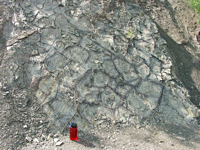 |
|
| Fig. 6-61. Formation of cross bedding caused by the migration of ripples or dunes | Fig. 6-62. Desiccation mud cracks in Precambrian rocks, Grand Canyon, Arizona |
|
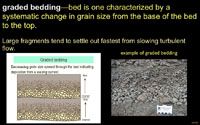 Fig. 6-63. Appearance and example of graded bedding in sedimentary deposits. Graded beds will "fine-upward" as currents slow down. They may "coarsen upward" if the energy of the depositing flow (current) increases. |
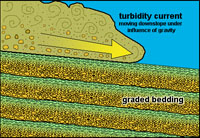 Fig. 6-64. Turbidity currents flow down slope under water under the influence of gravity. At peak flow, turbidity currents will scour the seabed, but as flow slows and stops, coarse sediments are deposited first, and finer material last. |
Deep Sea Fan and Turbidite DepositsA deep-sea fan is a fan- or delta-shaped sedimentary deposit found along the base of the continental slopes, commonly at the mouth of submarine canyons. Deep sea fans form from sediments carried by turbidity flows (density currents) that pour into the deep ocean basin from the continental shelf and slope regions and then gradually settle to form graded beds of sediment on the sea floor. Deep-sea fans can extend for many tens to hundreds of miles away from the base of the continental slope and an coalesce into a broad, gently sloping region called a continental rise. Turbidites are sedimentary deposits associated with turbidity flows—they commonly appear as interbedded layers of sandstone and shale. Conglomerate typically occurs in thicker beds and were originally deposited as gravel and mud on ancient submarine fans closer to the mouths of submarine canyons or in channels carved into the seabed. |
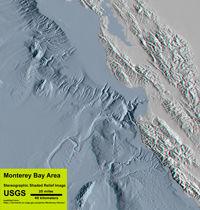 |
 |
| Fig. 6-65. Turbidity currents scour submarine canyons in the deep offshore environment and deposit sediments in the deep ocean. Deep-sea fans build up the continental rise region at the base of the continental slope and spread for hundreds of miles seaward, sometimes extending onto abyssal plains. | Fig. 6-66. Cretaceous-age turbidites (turbidity current deposits) at Bean Hollow State Beach, California. Each layer represents an undersea "storm" (turbidity flow) that spread across a deep sea fan on a continental rise. They were pushed up by tectonic uplift along the coast. |
Abyssal ClaysAbyssal clays are very fine-grained sediments, mostly clay minerals and iron-rich mineral dust that are mostly blow in by the wind from distant terrestrial sources. Much of the abyssal clay components are derived from dust storms in the world's desert regions and from explosive volcanic eruptions that can blow fine particles high into the atmosphere. Abyssal clays are also fine-grained material carried and redistributed by ocean currents such as tail end of far-turbidity currents that can travel hundreds to even thousands of miles away from continental margins. Abyssal clays in the deep ocean basins accumulate very slowly relative to other ocean sediments. Some of the fine-grained material can possibly be from cosmogenous sources in some locations. Abyssal clays dominate sediments on the seafloor in the northern Pacific Ocean basin (see discussion on volume and distribution of marine sediments (in Figure 6-18 above). |
Biogenous Sediments in the Marine EnvironmentBiogenous sediments include sediments formed by accumulation of organic materials. Biogenous sediments are mostly composed of the remains of organisms (including skeletal remains of microplankton (both plants and animals), plant remains (wood, roots, and leaves) and remains of larger animals including shells of invertebrates, such as shells, coral fragments, and fish and other vertebrate teeth, bone, and scales, and fecal material left behind by any type of organism. Biogenous sediments may be partly mixed with lithogenous sediments (continental-derived sediments) in coastal regions, particularly where streams and rivers contribute sediments.Bioaccumulation is the buildup of organic remains, such as deposits associated with coral reefs, shell or bone beds, and algae and ooze (calcareous and siliceous). On land bioaccumulation in swampy environments produces peat beds (with burial and time, peat eventually can be converted to coal). In many passive margin regions in tropical regions, carbonate sediments form and accumulate forming massive deposits along continental margins. Carbonate ReefsA reef is a general name for a ridge of jagged rock, coral, or sand just above or below the surface of the sea. A carbonate reef is one that is made of skeletal material composed of coral, coralline algae, and other carbonate skeletal material. Carbonate reefs are commonly called coral reefs but not all organisms that look like corals are actually corals—other organisms that create solid structure (branching or not) include coralline algae, bryozoans, sponges, stromatoporoids, and many other types of invertebrates). Figure 6-67 illustrates the variety of settings and features associated with carbonate depositional environments.Carbonate (coral) reefs form in clear shallow, warm, tropical marine waters. Over time, lime sediments are produced by biological activity in and around carbonate reefs. Carbonate reefs grow at rates of 10-30 feet per thousand years. Wave action and currents will erode and redistribute lime sediments offshore where it may accumulate, slowly building up massive carbonate platforms (becoming regions underlain by limestone). Examples of carbonate platform regions include the Bahamas, South Florida, and the Yucatan Peninsula (Figure 6-68 and 6-69). The world's largest reef system is the reef tracts, islands, and tidal shoals associated with the Great Barrier Reef located along the east coast of Australia (Figure 6-70). The Great Barrier Reef is composed of over 2,900 individual carbonate reefs and about 900 islands stretching for over 1400 miles (2,300 km) along the northeast coast of Australia and encompassing about 133,000 square miles (344,400 km2). It is the largest feature of biological origin on Earth. Similar reef tracts have formed throughout geologic history in other locations around the world. |
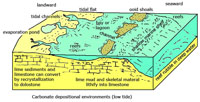 |
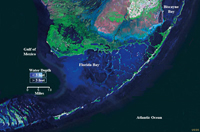 |
| Fig. 6-67. Carbonate depositional environments include coral reefs, keys, shoals, tidal flats, bays, and other coastal and offshore features. | Fig. 6-68. South Florida is part of a growing carbonate platform with the Keys consisting of an ancient and modern forming a barrier reef complex. | |
 Fig. 6-69. Carbonate platforms surround much of the Gulf of Mexico. They include continental shelf regions around the Yucatan Peninsula, South Florida, and islands of the Caribbean where Biogenous sediments form and accumulate. |
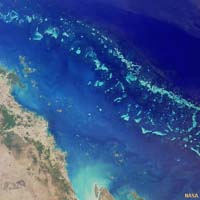 Fig. 6-70. Great Barrier Reef - The world's largest organic deposit. The growth of the great reef tract has kept pace with the global rise in sea level since the end of the Wisconsinian ice age. |
|
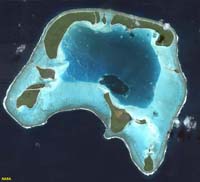 |
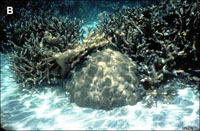 |
|
| Fig. 6-71. Atolls are volcanic islands or seamounts covered or surrounded by fringing carbonate reefs that build up even long after the volcano stopped erupting. | Fig. 6-72. Lime mud and sand accumulating around a living coral reef. Fine limey sediments are created mostly by organisms feeding on other reef organisms. |
Limey Sediments and LimestoneLime mud is sediment composed of calcium carbonate (CaCO3) derived from the skeletal remains of shelled organisms, coral, and calcareous algae and plankton. Large amounts of lime mud is created by waves battering reefs and reef organisms (including dead corals and other calcareous skeletal material) being chewed up and excreted by reef-living organisms (Figures 6-72). With compaction and cementation (lithification) limey sediments become limestone (Figure 6-73).Limestone is a sedimentary rock consisting predominantly of calcium carbonate (CaCO3); the rock must have >50% calcium carbonate to be considered a limestone. Some limestones preserve large quantities of fossil material as crushed up shells or even old reef communities are sometimes preserved in nearly intact orientation of the corals and other calcareous organisms. These organic remains are made up of tiny crystals of two mineral forms of CaCO3—calcite and aragonite. Aragonite is more soluble and is chemically less stable, and will usually convert to calcite with time. Most limestone exposed throughout the United States formed in ancient shallow marine seaways that flooded portions of the continent in the geologic past. Large regions within the United States are underlain by thick sequences of limestone rock formations representing all geologic time periods from Precambrian age to the present (Figure 6-74). In many locations the limestone beds are many thousands of feet thick. Most caverns form in limestone. Sinkholes form in limestone regions (See Sinkholes [USGS]) Limestone is commonly used in the manufacture of lime for cement, used as building stone, and used to manufacture steel and many other products. Ancient carbonate deposits contain some of the world's largest petroleum reserves. |
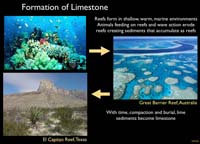 Fig. 6-73. Skeletal remains of calcareous reef organisms erode and accumulate over time. "Limey" (shallow and warm) depositional environments are where lime sediments accumulate. Lime sediments turn to limestone. 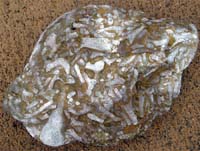 Fig. 6-75. Fossiliferous limestone. This sample from Ohio is loaded with ancient coral-like fossils called bryozoans (not corals). |
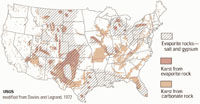 Fig. 6-74. Map of the United States showing the location of carbonate rocks in the subsurface. Limestone rock formations occur under about 40% of the continental United States! 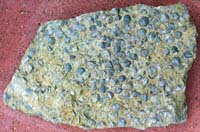 Fig. 6-76. Fossiliferous limestone. This layer from Cincinnati, Ohio is loaded with ancient brachiopod shells that accumulated in an ancient inland seaway. |
Oozes |
The oceans are full of many varieties of microscopic organisms, but only several varieties are responsible for generating vast quantities of biogenous sediments.Ooze is slimy mud sediment (soft and mushy) on the bottom of an ocean or lakebed formed from the accumulation of skeletal and organic remains of microscopic organisms (phytoplankton and zooplankton). • Oozes can be dominantly calcareous or siliceous in composition. • To be considered an "ooze" sediment must consist of >30% biogenous material (Figure 6-77). • Oozes form slowly - accumulating at a rate of 1/2 to 2 1/2 inch per 1000 yrs. • Oozes form in low energy environments and are very fine grained (clay sized particles). |
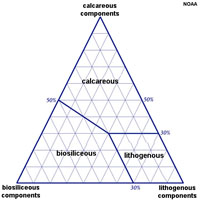 |
| Fig. 6-77. Components of oozes: calcareous, biosiliceous, and lithogenous materials |
Calcareous oozesCalcareous oozes are sediments dominantly composed dominantly of calcium carbonate (CaCO3). Two dominant groups of microorganisms that contribute carbonate remains: Coccolithopores (phytoplankton) and Foraminifera (zooplankton) |
CoccolithoporesCoccolithopores are single-celled marine phytoplankton (microscopic plants) that live in large numbers throughout the upper layers of the ocean. Unlike any other plant in the ocean, coccolithopores secrete shells of microscopic plates made of calcite (CaCO3). These scales, known as coccoliths, are shaped like hubcaps and are only three one-thousandths of a millimeter in diameter (Figure 6-78). Coccolithopores are part of base of the food chain and contribute vast quantities of coccoliths as sediment to large regions of the ocean basins. Coccoliths are concentrated in calcareous ooze.Coccoliths first appear in the fossil record in Triassic time. Because they are composed of low-magnesium calcite (the most stable form) they are easily fossilized and preserved in sedimentary rocks. What is a Coccolithopores? (NASA) |
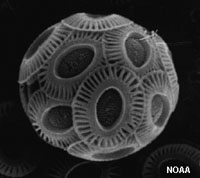 |
| Fig. 6-78. A Coccolithopores is covered with calcareous plates called coccoliths. |
Foraminifera (Forams)Foraminifera (or forams) are a large group of single-celled zooplankton, most species have calcareous shells (or tests). Their shells are commonly divided into chambers which are added during growth and form patterns including spirals, open tubes, or hollow spheres (Figure 6-79). Depending on the species, the shell may be made of crystalline calcite, organic compounds, or sand grains and other particles cemented together. They are usually less than 1 mm in size, but some species grow much larger, reaching up to 20 cm. The majority of foraminifera species are benthic (meaning they live on or within the seafloor sediment) while typically smaller varieties are floaters (planktonic) in the water column at various depths. Foraminifera are found in all depths of the ocean, although deep ocean varieties do not have calcareous tests. They contribute a significant volume of sediments to carbonate reefs and a major component of carbonate oozes throughout ocean basins.Over 10,000 species are recognized, both living and fossil. They first appeared in the fossil record in Cambrian time. |
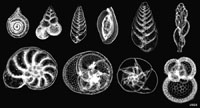 |
| Fig. 6-79. Examples of foraminifera tests. | |
 |
|
| Fig. 6-80. Pyramids of Giza, Egypt are constructed with foraminiferal limestone. |
Calcium carbonate compensation depth (CCD)Calcareous sediments are fairly evenly distributed in oceans, but their occurrence is influenced by the solubility of calcium carbonate. Calcium carbonate forms and is stable in shallow, warm seawater, but it will dissolve in cold seawater. Carbon dioxide dissolves easily in cold water, so CaCO3 will dissolve in cold water. The calcite compensation depth (CCD) is the depth in the oceans where the rate of calcium carbonate material forming and sinking is equal with the rate the material is dissolving. Below the CCD no calcium carbonate is preserved—generally there is no CaCO3 beneath about 15,000 feet (4500 meters) (Figure 6-81).Skeletal remains composed of calcium carbonate (CaCO3) sinking into the deep ocean are mostly microscopic plankton. As carbonate materials settle or are moved by currents in to deep water, the smallest fragments dissolve before larger, denser fragments. The lysocline is the depth at which CaCO3 begins to dissolve rapidly. |
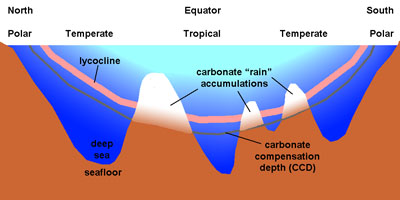 |
| Fig. 6-81. Relationship of the lysocline and the carbonate compensation depth (CCD) relative to depth of the ocean and latitude. The lysocline and CCD are at the surface near the poles where the water is cold. Calcareous oozes accumulate only above the CCD. |
ChalkChalk is a soft, fine-grained, white to grayish variety of limestone that is composed of the calcareous skeletal remains of microscopic marine organisms including coccoliths and foraminifera. Some of the purest varieties can have up to 99 percent calcium carbonate (see Figure 6-82). The White Cliffs of Dover, England are one of the most iconic landscape features in the United Kingdom. The White Cliffs consist of Cretaceous-age chalk deposited about 89 to 85 million years ago in more tropical conditions than exist in the region today. The layers of chalk reach nearly 500 meter thick. The sediment the chalk formed from was coccolithopore ooze. |
 |
| Fig. 6-82. The White Cliffs of Dover, England are chalk. |
Siliceous oozesSiliceous oozes are sediments dominantly composed dominantly of SiO2 (silica).Two dominant groups of organisms that contribute siliceous remains: diatoms and radiolarians. DiatomsDiatoms are the most common plankton. Diatoms are phytoplankton (single-celled microscopic marine plants).• Diatoms are most common in polar regions, but are also know from tropical and subtropical regions as well. • Very important for upwelling nutrients (where deep water rich in . • Diatoms have many economic uses including in beer filters, pool filters, and optical glass. |
 |
| Fig. 6-83. Example of diatoms. These are images taken with a microscope. |
RadiolariansA radiolarian is a single-celled aquatic animal (zooplankton) that has a spherical, amoeba-like body with a rigid spiny skeleton of silica. There are hundreds of known species of radiolarians (See a list on radiolaria.org website).Figure 6-85 is a photomicrograph depicting the siliceous tests of ten species of marine radiolarians. Upon death, their tests can accumulate on the seafloor and form siliceous marine sediments known as radiolarian ooze (a form of siliceous ooze). Radiolarians first appear in the geologic record in early Cambrian time and have experienced several periods of proliferation and extinctions as recorded in the geologic record. Today, radiolarians are more common in equatorial regions. |
 |
| Fig. 6-84. Example of Radiolarian skeletons (tests). These are images taken with a microscope. |
ChertChert is a fine-grained siliceous sedimentary rock. It is a hard, dense, and consist chiefly of interlocking microscopic crystals of quartz and may contain opal. It has a conchoidal fracture and may occur in a variety of colors. Most chert forms from recrystallization of siliceous microplankton remains (siliceous ooze eventually looses its water content, recrystallizes and turns into chert.Organic residues preserved as chert beds are known from rocks dating back to early Precambrian time. Banded-iron formations (BIFs) are composed of interbedded layers of iron-oxide minerals and chert, and are thought to be biogenous in origin. Younger marine cherts are mostly formed from diatoms and radiolarian oozes. |
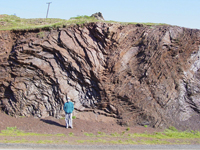 |
 |
| Fig. 6-85. Layers of marine chert exposed in the Marin Headlands, California | Fig. 6-86. Banded-iron formation (with chert) from the Precambrian era. |
Sedimentary Rock FormationsA rock formation is the primary unit of stratigraphy, consisting of a succession of strata useful for mapping or description. A rock formation typical consists of a unique lithology (rock type) that has a relatively defined geologic age and is considered mappable (occurs throughout area or region, both on the surface and in the subsurface. Rock formations can be of igneous, sedimentary, or metamorphic origin. Sedimentary rock formations preserve information (including fossils and sedimentary structures) about the sedimentary environments they formed in. Figures 6-87 to 6-89 are examples of marine sedimentary rock formations. |
 |
 |
 |
| Fig. 6-87. Ancient beach, bay, and coastal dune deposits exposed in rock formations at the Del Mar Dog Beach, San Diego County, California | Fig. 6-88. Ancient continental shelf deposits preserved in the Santa Cruz Mudstone Formation (Miocene-Pliocene age) in Santa Cruz, CA | Fig. 6-89. Ancient deep ocean siliceous ooze deposits preserved as ribbon chert in the Franciscan Formation (Jurassic age), Santa Cruz Mountains, CA |
Finally, food for thought...Nuclear bomb testing and nuclear power-plant disasters has created a new identifiable sediment boundary preserved in Holocene sediments worldwide. This boundary is now associated with a proposed new epoch of the Quaternary Period called the Anthropocene — when human activities became plausibly the dominant force causing changes to Earth's global physical environment.The United States conducted surface nuclear testing at Bikini Atoll in the South Pacific. Testing took place between 1946 and 1958. During that time, 23 nuclear devices were detonated at seven test sites on the reef itself, on the sea, in the air and underwater. So far, 8 nations in 2016 have successfully tested nuclear weapons. Whereas the last atmospheric nuclear test was in 1980, underground testing has continued. Another proposed epoch name, not yet adopted, is perhaps.... Weshouldhavecene. |
 Fig. 6-90. H-bomb test destroys Bikini Atoll Fig. 6-90. H-bomb test destroys Bikini Atoll |
| Chapter 6 quiz questions |
